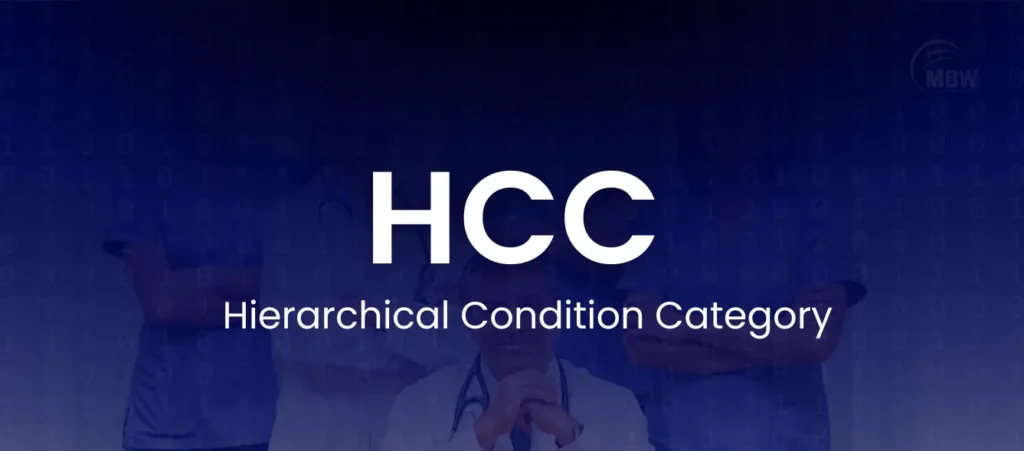Hierarchical Condition Category (HCC) coding has emerged as a cornerstone in healthcare reimbursement. In Medicare Advantage and other risk-adjusted programs, HCCs influence how patient care costs are predicted and how payments are adjusted. Without accurate HCC reporting, organizations risk underrepresenting patient complexity and receiving lower reimbursements.
In this blog, we explain how the hierarchical condition category system impacts your practice, RAF scores, and CMS risk models. Learn how Medical Billing Wholesalers improve your HCC risk adjustment accuracy.
What is HCC Medical Abbreviation?

The term “hierarchical condition category” refers to diagnosis groupings that predict future healthcare costs. These categories assign values to chronic and severe conditions based on treatment burden and frequency.
What Is Hierarchical Condition Category (HCC) and How Does It Work?
A hierarchical condition category (HCC) groups clinically related diagnoses based on expected healthcare costs. As a result, CMS and payers predict future expenditures more accurately. HCCs are selected through data-driven processes that tie diseases to spending patterns over time.
How HCC Impact Reimbursement
Hierarchical condition categories link to patient risk scores. More severe and chronic diagnoses yield higher RAF scores, leading to better funding for providers. Without capturing all relevant HCCs, practices may lose significant revenue.
“Without HCC coding, billing would be like sending a weather report based on guessing the sky color.”
Why Hierarchical Condition Category Coding Accuracy Matters
Hierarchical condition category coding affects not only payments but quality reporting. Each documented chronic illness reflects directly in the RAF score. As such, providers must maintain rigorous documentation standards.
Common Mistakes That Lower RAF Scores
Common errors include using unspecified codes, missing eligible diagnoses, and poor provider documentation. Fortunately, deploying clinical documentation improvement (CDI) programs and real-time chart audits can minimize these risks effectively.
Diagnoses Under Hierarchical Condition Categories
| ICD-10 Code | HCC Category | Condition Description |
|---|---|---|
| E11.9 | HCC 19 | Type 2 Diabetes Mellitus |
| I50.9 | HCC 85 | Heart Failure, Unspecified |
| J44.9 | HCC 111 | COPD, Unspecified |
| C34.90 | HCC 8 | Malignant Neoplasm of Lung |
How CMS Calculates Risk Adjustment Factor (RAF) Scores Using HCC
CMS uses hierarchical condition categories to determine each patient’s RAF score annually. Each HCC adds a weight to the patient’s risk profile. This combination drives adjusted capitation payments to providers and plans.
Understand more about how CMS calculates RAF scoring below.
Why Chronic Conditions Hold More Weight in HCC Coding
Chronic conditions predict higher ongoing costs. For this reason, diagnoses like COPD and congestive heart failure carry higher risk weights. Recapturing these every year is critical to preserve revenue.
“Missing one chronic HCC is like forgetting the main ingredient in your favorite recipe—costly and disappointing.”
Calculating the RAF Score
The Risk Adjustment Factor (RAF) represents the estimated care cost for a patient based on their demographics and chronic conditions. RAF scores are recalculated annually and influence the capitation payments providers receive in Medicare Advantage.
For example, consider a 72-year-old male with chronic kidney disease stage 3, Type 2 diabetes with renal complications, and major depressive disorder. Each condition contributes to the final RAF value, including interaction terms that increase the cumulative risk score.
| ICD-10-CM Code | Description | RAF Score |
|---|---|---|
| NA | Demographics (age, gender) | 0.315 |
| E11.22 | Type 2 diabetes with renal complications | 0.318 |
| F33.1 | Major depressive disorder, recurrent, moderate | 0.234 |
| N18.30 | Chronic kidney disease, stage 3 | 0.251 |
| NA | Interaction (Diabetes + CKD) | 0.123 |
| Total RAF Score | 1.241 |
This optimized RAF score determines the monthly reimbursement a provider receives under a capitated payment model. Patients with higher RAF scores generate increased payments due to expected care needs.
What Happens When Hierarchical Condition Category Coding Is Missed?

Missing HCC codes causes RAF scores to drop. Consequently, providers face lower payments despite managing high-risk patients. Furthermore, data reporting for value-based contracts may appear weaker than reality.
How To Avoid Missing Critical HCCs
Proactive solutions include annual wellness visits, concurrent coding reviews, AI-driven coding assistance, and provider training. Practices that implement these strategies see substantial improvement in RAF scores.
How Interaction Terms and Hierarchies Affect HCC Coding
Hierarchical condition categories are structured so only the most severe diagnosis in a group counts. Interaction terms boost RAF scores when comorbid conditions like diabetes and heart failure coexist.
Examples of HCC Interactions: Patients with both diabetes complications and CHF receive additional RAF weight compared to those with only one condition. Documenting every diagnosis matters greatly in risk-based payments.
Importance of Annual Hierarchical Condition Category (HCC) Diagnosis Recapture
CMS resets risk scores annually. Thus, chronic conditions must be documented every calendar year. Failure to recapture diagnoses like CKD or COPD causes underpayments in subsequent years.
“Skipping yearly HCC documentation is like expecting last year’s umbrella to shield you from today’s storm.”
Understand how CMS requires annual risk data submission.
How Hierarchical Condition Category Is Used Beyond Medicare Advantage
While created for Medicare Advantage, HCC models are now widely adopted in Medicaid managed care organizations and ACA marketplace plans. Even large commercial insurers build risk programs based on HCC logic.
HCC Knowledge Benefits All Healthcare Organizations
As value-based payments grow, understanding and applying HCC principles allows providers to thrive across all payer types, not just government-sponsored programs.
CDI Programs Strengthen HCC Reporting
Clinical Documentation Improvement (CDI) programs help bridge the gap between clinical care and coding. They ensure complete, accurate capture of patient risk through focused provider education and chart audits.
Building a Sustainable CDI Process for HCC Success
CDI success depends on consistent feedback loops, provider engagement sessions, and integration into routine chart review workflows.
Conclusion: Mastering Hierarchical Condition Category (HCC) for Long-Term Success
Hierarchical condition category coding forms the backbone of modern healthcare payment models. Providers who master complete HCC capture, annual recapture processes, and RAF optimization will lead value-based care initiatives. Building internal workflows, investing in technology, and prioritizing provider documentation education are keys to long-term success in risk-adjusted environments.
Partner with Medical Billing Wholesalers for strategic HCC risk coding solutions.
Frequently Asked Question
1. What is a Hierarchical Condition Category (HCC)?
It is a diagnostic group that predicts future healthcare costs and adjusts provider reimbursements accordingly.
2. How often must chronic HCC conditions be recaptured?
Every year. Even stable conditions must be redocumented annually for RAF scoring.
3. What happens if HCC codes are missed during documentation?
Missed codes lower RAF scores and can result in thousands of dollars in lost revenue per patient.
4. Are HCCs used only in Medicare Advantage?
No, Medicaid and commercial payers increasingly use similar models to adjust payments.
5. How can a provider improve their HCC capture rates?
Adopting CDI programs, offering EHR prompts, and performing proactive chart reviews significantly improve HCC capture.

